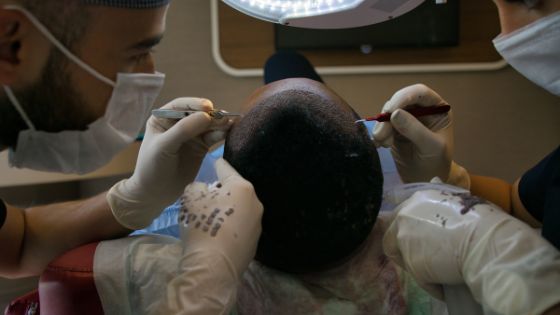There is a need to consult with a hair specialist if you notice a wider hair part, loose hair up to 125 daily, and bald spots. Hair loss is of different types and is caused by different reasons. Preventing hair loss is not easy, but you may find a solution should you see a doctor on time.
Defining women’s hair loss
When women suddenly lose so much part of their hair, it’s known as hair loss. Shedding of hair is a natural process where hair falls off, and new ones grow. Overall, 50 to 100 hairs are lost each day. But hair loss becomes the case when one loses hair, and it’s not replaced. Shedding of hair and hair loss are not the same.


There are different types of hair based on texture and length. Vellus hair is fine, short, and light hair. Hair that is very thick, dark, and long is called androgenic or terminal hair.
Hair growth cycle
3 phases of growth are noticed in growing hair:
- Anagen phase. Known as the growing phase, this has a timeline of 2 to 8 years. This phase makes up between 85 to 90 percent of the hair on the head.
- Catagen phase. This is the transition phase where there’s shrinkage of hair follicles, and the timeline is 2 to 3 weeks.
- Telogen phase. The resting phase of hair. Duration is around 2 to 4 months. Hair falls out when this phase is completed.
Hairs short in lengths like those found on the legs, eyebrows, arms, and eyelashes have a short anagen phase (around 1 month). Hair on the scalp can stay for 6 years and above.
Hair loss types
- Anagen effluvium. This loss is triggered by some medications and medical procedures like chemotherapy. It stops hair follicle growth.
- Telogen effluvium. When so much hair has grown to the telogen (transition) phase, they fall out – hair loss.
- Androgenetic alopecia. A prevalent hair loss type where head hair and those on the sides thin out. Other names are female pattern hair loss baldness or female pattern alopecia.
Women that have lost their hair may get it back via our turkey hair transplant package.
How often do women lose hair?
Contrary to the belief that only men lose hair, it has been established that greater than 50% of women will lose their hair significantly. Female pattern hair loss is primarily responsible for the loss of female hair. A third of women are affected by this condition.
Which women are prone to losing hair?
Both young and old women may go through a loss of hair, but more of this problem is noticed in females:
- Above 40 years
- Experiencing menopause
- Who just gave birth
- Using certain medications and having undergone chemotherapy
- Whose hairstyles are very tight or those using toxic hair chemicals
Are there myths about hair loss?
Yes. And they are very common. However, the following myths are incorrect:
- Hair loss is caused by excessive shampooing, coloring, or perm
- Women with dandruff on their hair will lose it permanently
- Stress will cause permanent loss of hair
- Shaved hair causes regrowth of thicker hair
- Standing on your head will make it grow more
- Healthy hair comes when you brush your hair 100 strokes daily
- Wearing a wig and hat brings about hair loss
- Intellectual women are the only people susceptible to hair loss
What causes female hair loss?
Common causes of hair loss include:
- Lack of vitamins
- Special diet plan
- Loss of weight via dieting
- Excessive processing of hair on the scalp
- Very tight hairstyles that put pressure on the hair roots. Hair loss caused by this is known as traction alopecia. Damaged hair follicles could cause permanent hair loss
See our post on the A to Z of hair loss to learn more about the causes of different types of hair loss.
Hair loss in menopausal women
In menopause, women may begin to have hair where there wasn’t, or existing hair may thin out. A reason may be menopausal hormonal changes. The levels of estrogen and progesterone drop, thus increasing the effect of the male hormones.
Hair follicles may shrink during and post-menopause. The growth of hair is prolonged, and shedding is more frequent.
The doctor will examine you extensively and examine your medical history to provide a solution to your hair growth changes. There may be testing of your iron or thyroid hormone levels. The doctor may prescribe another medication if the current one is causing hair loss.
Hair loss symptoms in women
- Increasing daily hair loss after combing, bathing, or sleeping
- Visible patches of missing hair or thinner hair plus wider hair part
- Visible hair breakage
- Smaller ponytails
- Scalp skin is visible through the hair
Diagnostic tests for hair loss
These may range from simple to complex:
- Pulling the hair gently to know how many fall out
- Blood tests to measure levels of essential vitamins, minerals, and hormones
- Microscopic and trichoscopy scalp exam
- Scalp biopsy to take out and study a piece of scalp skin
Likely questions your doctor may ask during a consultation
Questions about your habits
- What hair products do you use?
- What hairstyles do you have on?
- Do you like hair pulling
Questions on your health history
- Are you going through stress right now?
- Do people in your family have hair loss?
- What are your daily medications and supplements?
- What’s your diet like?
- Any past experience of hair loss?
Questions about your observations
- When did you start noticing hair loss?
- How long has it been since your hair loss started?
- Do you lose hair in other body parts other than your scalp?
- What makes you lose more hair?
Who treats loss of hair in women?
Our dermatologist at Turkey Hair Transplants treats women’s hair loss.
Treating hair loss in women – medications and supplements
Hair loss will be treated according to its causes.
- For stress and changes in hormones: No treatment is needed. It will disappear after some time.
- For tight hairstyles. Having loose hairstyles can correct this.
- For nutritional deficiency. A daily dose of supplements like multivitamins may be prescribed.
- For female pattern hair loss. Minoxidil may be recommended. But it’s not for pregnant, intending to get pregnant, or breastfeeding mothers. Laser-approved products can also help.
There are other effective but yet to be approved medications for the treatment of female hair loss, including:
- Spironolactone and other anti-androgens.
- Finasteride and other alpha-reductase enzyme inhibitors.
- Estrogens and more
Please note that women yet to experience menopause are not allowed to use hair loss treatment without birth control. Minoxidil, Finasteride, and other drugs are not good for women who are or planning to get pregnant.
Surgery to transplant hair is also a solution to hair loss. Bald areas are implanted with hair collected from regions with hair. Hair transplant surgery may come with risks like loss of shock and infection. Another problem with this option is getting enough hair to cover large areas of baldness. Again, surgery can cost more and has no insurance cover.
For hair growth stimulation, protein-rich plasma (PRP) injections can work. The blood taken from a patient is used to make these injections where the platelets are separated, concentrated, and placed back in the blood.
Another method is micro-needling of the scalp with and without using minoxidil.
Does treatment come with side effects or complications?
The scalp may get irritated, dry, itchy, scaly, or reddish with minoxidil. Contact your doctor if you notice these signs. Another side effect of minoxidil is hair growth on the forehead cheeks – areas aside from the scalp. Be sure to have your face washed after the application of minoxidil, and don’t rub it on other areas of the body.
Ways to prevent loss of hair in women
It’s impossible to avoid hair loss if the causes are aging, injury, disease, or genetics. For causes like tight hairstyles and harsh chemicals, avoiding such choices can help. Quitting smoking is also helpful. Hair loss can be kept at bay with a healthy balanced nutritious diet.
What should women with hair loss look out for?
It depends on your diagnosis outcome:
- Overtime, shedding due to anagen or telogen may stop
- Treat hair loss related diseases
- Mascarade hair loss with a hat or wig
- Treating hair loss on time increases the chances of regrowth and lower thinning
Hair loss may not be bad, but women don’t like how they look in this condition. Loss of hair may cause low self-esteem and withdrawal. According to the latest studies, certain conditions like diabetes, endocrine disorders, and metabolic syndrome are linked with female pattern hair loss.
Tips for improving hair loss
Colouring, head massage, and the right hair products can give your hair more thickness. Contact your doctor once you notice hair loss.
Likely questions to ask your doctor
- What’s causing my loss of hair?
- What’s my hair loss type?
- How much hair am I losing daily?






















